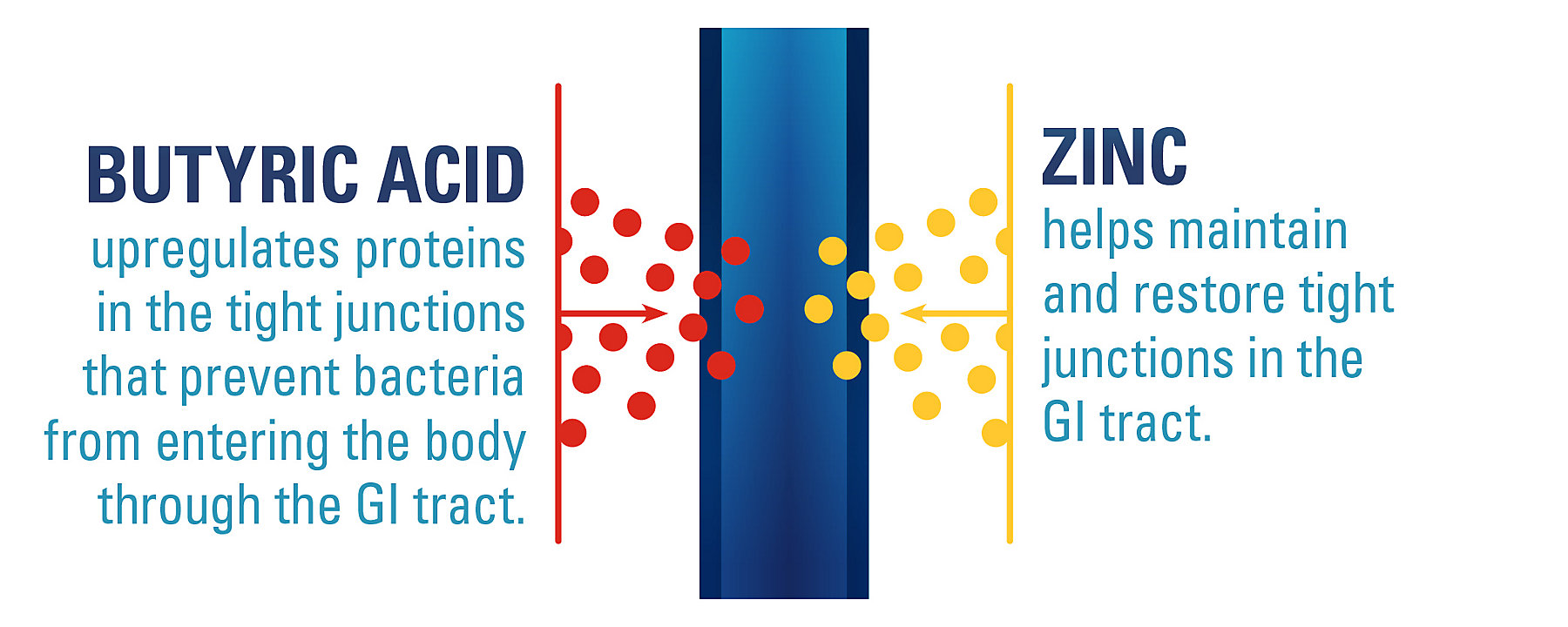Zinc, an essential mineral, is a component of more than 300 enzymes in the body. It helps maintain and restore the tight junctions in the epithelial tissue lining the GI tract, thereby preventing toxins from entering the digestive system and causing inflammation that leads animals to stop eating and experience poor feed performance. Zinc is also important to the body’s ability to produce T cells — key adaptive immune system components that act against invading pathogens. Additionally, zinc can play other defense roles, particularly under stress conditions.
“Tight junctions are made up of multiple proteins, and zinc is important in how it facilitates the production and maintenance of those tight junction proteins,” Mani said. “Zinc supplementation is especially helpful during heat stress when those tight junctions would otherwise become compromised. It’s important to maintaining the critical barriers of epithelial cells.”
These two key compounds are complementary to the general desired result of ButiPEARL Z4 — minimizing the harmful effects of heat stress — but they attack the problem from different angles.
“The functions are different but interconnected,” Mani explains. “Zinc is going to protect the intercellular tight junctions, and cells will wind up being healthier. That way, they’re more likely to absorb butyric acid and become even healthier. They don’t act in a sequential manner.
“It’s just like an athlete eating a healthy diet so he or she can practice more: Is it the food or the practice that makes him or her better? They’re both equally important. That’s what ButiPEARL Z does: It delivers two molecules important to intestinal health, making them available to GI cells simultaneously to deliver the greatest benefit.”
Delivering Compounds Where They Need to Go
Controlling the release of key ingredients can sometimes be a challenge with feed additives like ButiPEARL Z. That’s why it is encapsulated in MicroPEARLS™ that help make those ingredients available to the right tissues in the digestive tract. Without encapsulation, key ingredients would be absorbed immediately upon entering the digestive tract instead of being made available to the lower portions of the gut, where they’re needed most.
The pearls are a combination of fats, oils and other proprietary molecules that help deliver ingredients consistently throughout the gut. The encapsulation slowly dissolves when the pearls transit through the intestinal tract, gradually allowing key ingredients to escape through pores on each pearl’s surface. This method of delivery sharply increases the efficacy of ButiPEARL Z in staving off the negative effects of heat stress on gut health by distributing the product throughout the tract.
“If you give butyric acid without encapsulation, it will go into the gastrointestinal tract and immediately be absorbed, then either used or expelled immediately in feces or urine,” Mani adds. “Encapsulating it releases the product continuously through the entire intestine. Our chemists have found encapsulation methods that will enable the product to be released in the small intestine, then more once it gets into the cecum and colon, where almost everything will be released. Very little releases early on. The product goes to the places where it is supposed to function in sufficient quantities.”
Encapsulating zinc in MicroPEARLS also has a herd management benefit. When encapsulated, a producer or nutritionist knows the specific source of the zinc when there may be other zinc sources in a specific feed ration. That information is helpful in determining the efficacy of the encapsulated zinc, and in accurately administering the product in the future.
Management Considerations for Heat Stress and ButiPEARL Z
It’s impossible for producers to eliminate stress on their livestock completely. Even the act of consuming feed causes slight increases in stress hormones. Minimizing stress — like that from heat — and its negative effects on gut health is possible through the right combination of management and products, such as ButiPEARL Z. The two must be present simultaneously to ensure animals are healthy and productive.
“Management is very important; producers need to provide sufficient shelter, make sure their barns don’t get too hot, and make sure pigs have access to cold water in times when heat stress is likely. If those conditions are met, we can decrease the stress on the animals, especially when we administer ButiPEARL Z. This product alone is not going to solve all of your heat stress problems. Even under perfect conditions, animals are always going to be under some stress,” Mani said.
“It’s just like car insurance: You can insure your car and be protected, but you still have to drive carefully so you don’t damage your car and don’t hurt yourself. If you manage your pigs well, which most producers do, you will see the benefits of this product — ultimately, sustaining healthier animals and maximizing productivity in the face of heat stress.”
References
1Schieck, S. Heat stress in swine affects production. University of Minnesota Extension. extension.umn.edu/swine-production-management/heat-stress-swine-affects-production.
2Norimatsu, M., T. Ono, A. Aoki, K. Ohishi, T. Takahashi, G. Watanabe, K. Taya, S. Sasamoto, and Y. Tamura. 1995. Lipopolysaccharide-induced apoptosis in swine lymphocytes in vivo. Infection and Immunity. 63(2):1122-1126.
3Gourley, K. M., J. C. Woodworth, J. M. DeRouchey, M. D. Tokach, R. D. Goodband, and S. S. Dritz. 2016. Comparing the effects of butyric acid source and level on growth performance of nursery pigs. Kansas Agricultural Experiment Station Research Reports. 2(8).
4ButiPEARL™ — Encapsulated butyric acid for a healthy swine and poultry gut. Kemin Industries. Kemin.com/na/en-us/products/ButiPEARL.




